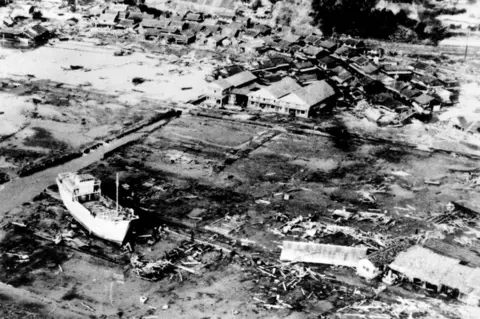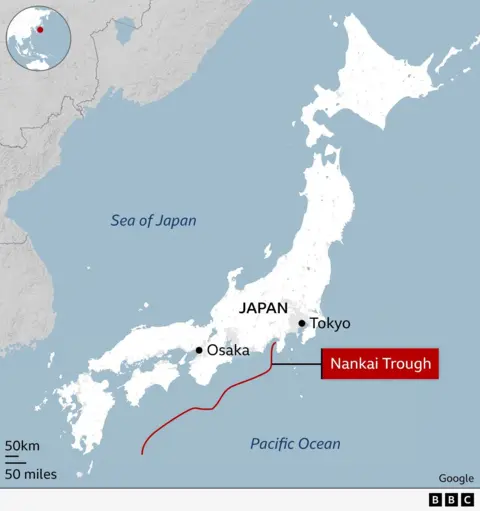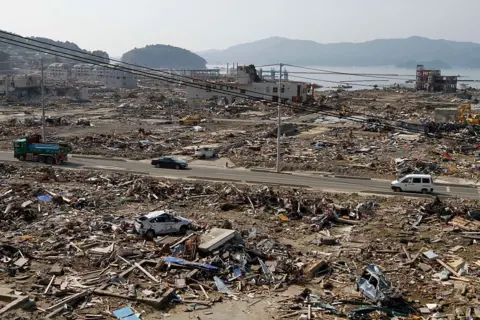At first glance, the earthquake that struck southern Japan on Thursday was no big deal.
The 7.1 magnitude earthquake did little damage and the tsunami warning was quickly downgraded.
But the earthquake was quickly followed by a warning – which had never been given before.
Japan’s meteorological agency said there was an increasing risk of a “major earthquake”. Japan’s prime minister has canceled a planned trip to a Central Asian summit in the country next week.
For many in Japan, thoughts turned to “the big one” — a once-in-a-century earthquake that many had grown up being warned about.
Worst-case scenarios predict more than 300,000 deaths, with a 30-metre wall of water likely to hit along the East Asian nation’s Pacific coast.
Which sounds scary. And yet, the overwhelming feeling Masayo Oshio was left with was confusion.
“I’m confused by the advice and I don’t know what to do with it,” she admitted to the BBC from her home in Yokohama, south of the capital, Tokyo.
“We know we can’t predict earthquakes and we’ve been told the big one is coming one day for so long, so I kept asking myself: is this it? But it doesn’t seem real to me.”
So what is the “big one”, can it be predicted – and is it likely to hit soon?
What are the Japanese authorities worried about?
 AP
APJapan is a country accustomed to earthquakes. It sits on the Ring of Fire and, as a result, experiences about 1,500 earthquakes a year.
The vast majority do little damage, but there are a few — like the one that struck in 2011 with a magnitude of 9.0, sending a tsunami up the northeast coast and killing more than 18,000 people.
But the one authorities fear could hit this most densely populated region in the south could – in the absolute worst case scenario – be even more deadly.
Earthquakes along the Nankai Valley – an area of seismic activity that stretches along Japan’s Pacific coast – have already been responsible for thousands of deaths.
In 1707, a rupture along its entire 600 km length caused the second largest earthquake ever recorded in Japan and was followed by the eruption of Mount Fuji.

These so-called “megathrust” earthquakes tend to strike every hundred years or so, often in pairs: the last were in 1944 and 1946.
Experts say there is a 70% to 80% chance that a magnitude 8 or 9 earthquake will strike somewhere along the valley in the next 30 years, with worst-case scenarios suggesting it would cause trillions in damage and potentially to kill hundreds of thousands.
And this long-awaited event, according to geologists Kyle Bradley and Judith A Hubbard, is “the original definition of the ‘Big One'”.
“The history of large earthquakes in Nankai is compellingly scary” enough to be disturbing, the pair admitted. in their Earthquake Insights newsletter on Thursday.
But can they actually predict an earthquake?
Not according to Robert Geller, professor emeritus of seismology at the University of Tokyo.
“Issuing the warning yesterday has almost nothing to do with science,” he told the BBC.
This, he argues, is because while earthquakes are known to be a “clustered phenomenon”, “it is not possible to say in advance whether an earthquake is a foreshock or an aftershock”.
In fact, only about 5% of earthquakes are “foreshocks,” Bradley and Hubbard say.
However, the 2011 earthquake was preceded by a magnitude 7.2 foreshock, they note — one that was largely ignored.
The warning system was put in place after 2011 to try to prevent a disaster of this scale again, and Thursday was the first time the Japan Meteorological Agency (JMA) used it.
 Getty Images
Getty ImagesBut most importantly, while he told people to prepare, he didn’t tell anyone to evacuate. Indeed, they were keen to downplay any imminent mass danger.
“The possibility of a new large earthquake is higher than normal, but this is not an indication that a large earthquake will definitely occur,” the JMA said.
However, Prime Minister Fumio Kishida announced that he had canceled his plans to travel outside Japan to “ensure that our preparations and communications are in order.”
He added that he feared people would “feel uneasy” given it was the first time such an advisory had been issued.
Masayo Oshio does not appear to be, however.
“I think the government is overdoing it,” she said.
Prof Geller was harsher, saying the advice was “not a useful piece of information”.
So why sound the alarm?
The system allows a lower level warning or alarm to be sent. Thursday was an alert, advising people to prepare to evacuate.
And, anecdotally, it seems to have worked. Even in a country used to getting alerts on their phones, the Nankai Trough effect — and the threat of the Big One — made people stop and take notice.
“One thing I did when I saw the advice was check what we have at home and make sure we’re prepared, as I haven’t done that in a while,” Masayo Oshio admitted.
And this is repeated along the Pacific coast.
In Nichinan, Miyazaki Prefecture, near the epicenter of Thursday’s 7.1, officials were inspecting the conditions of evacuation shelters already open. In Kochi Prefecture, western Japan, 10 municipalities opened at least 75 evacuation shelters by Friday morning, according to the Kyodo news agency.
Power plant operator Jera Co., a joint venture between Tokyo Electric Power Company Holdings Inc. and Chubu Electric Power Co., said it was on emergency alert, reaffirming communication routes with fuel carriers and evacuation protocols for piers.
In Kuroshio town, also in Kochi, elderly residents and others were asked to voluntarily evacuate to safer places. Officials in Wakayama Prefecture, western Japan, confirmed evacuation routes in cooperation with local municipalities.
Prof Geller – for all his skepticism – says it’s a good opportunity to “make sure you’re doing all the routine measures you should be doing anyway”.
“Have a week’s worth of water on hand, some canned food, and then maybe have some flashlight batteries,” he advises.
Additional reporting by Chika Nakayama and Jake Lapham

